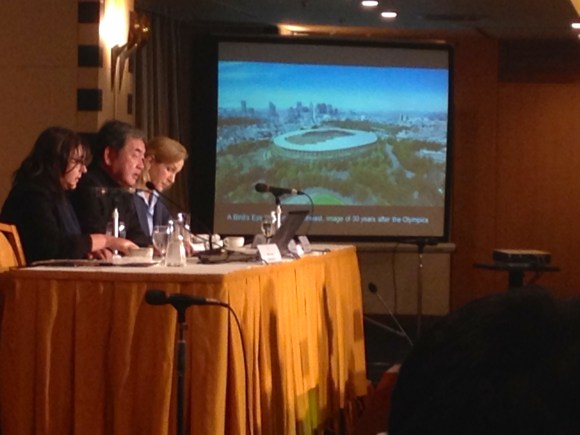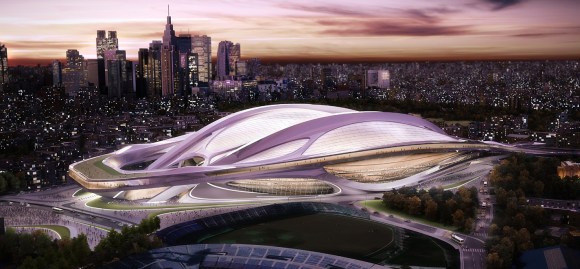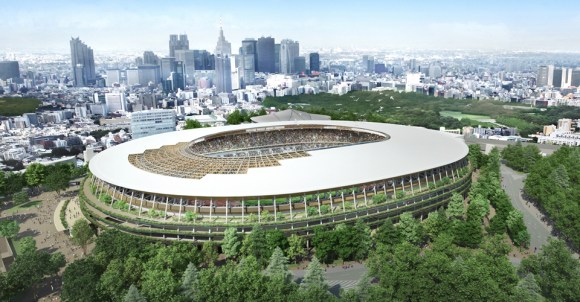
It seems controversy over the new National Stadium for the Tokyo 2020 Olympics isn’t over yet.
Let’s have a quick recap of the National Stadium saga for those of you playing along at home.
In the bid to get the Olympics, organizers decided to tear down the beloved 54,000-seat National Stadium in Shinjuku Ward, the centerpiece the 1964 Tokyo Olympics, and build a new stadium on the same site. In 2012, a design from award-winning Iraqi-British architect Zaha Hadid and her London-based firm was chosen.
▼ The original design by Zaha Hadid Architects

Tokyo was awarded the Games in September of 2013, but just three months later, Hadid was asked to revise her design due to ballooning costs. Even after the revisions, the total cost stood at 250 billion yen, more than three times the cost for the London 2012 main stadium and double the amount Tokyo organizers were hoping to achieve.
Organizers and Hadid disagreed on the cause of the budget problem, with Hadid placing the blame largely on rising material and manpower costs and the Olympic committee pointing the finger at difficult-to-build elements in the design. Hadid also suggested that resentment over a non-Japanese architect being chosen played a role in the conflict. Finally, her design was scrapped and another design competition was held.
The new winner was a design submitted by Japanese architect Kengo Kuma in cooperation with construction firm Taisei Corp. and design firm Azusa Sekkei Co., both of which were contractors working on the Hadid design.
▼Kengo Kuma’s design

Hadid and others pointed to similarities between the designs, the overlapping contractors and the fact that the new design was drawn up in just 14 weeks, compared to two years for Hadid’s original, to suggest that parts of the new stadium had been plagiarized from her work. These accusations were bolstered when the Telegraph reported that Japan Sport Council was withholding payment until Hadid signed a new contract releasing the copyright to her designs and submitting to a gag order on the matter. Hadid has refused to sign the new contract and threatened legal action.
Last Friday, Kuma held a press conference in Tokyo to talk about his design and he firmly denied that any of it was plagiarized.
Kuma admitted that there were some similarities between the two designs, but chalked this up to the requirements of the project. For example, both stadiums use a three-layer structure, but Kuma said this is the most reasonable arrangement to ensure good sight-lines. In fact, about 80 percent of the designs submitted in the contest used the same approach. Similarities in the layout of the seats were due to Tokyo fire codes, he said.
“The conditions of the competition mean automatically that there are certain technical similarities in the designs. However, in the design aspects of the stadiums, I would like to say that there are no similarities,” he stated.
He explained that Hadid’s design, which he praised as being “wonderful and unique”, uses a high saddle-shaped concept while his stays as low and flat as possible to better blend in with the character of the neighborhood and create a feeling of closeness between athletes and spectators. Additionally, he focused on using elements from traditional Japanese design, incorporating overhanging eaves and beams made from domestic wood.
He further stated that he was not privy to any of the discussions between the Japan Sport Council and Hadid, nor had he spoken with Zaha Hadid directly, so he was not aware of the details of their negotiations.
And now you are all caught up, Rocketeers. Good thing, too, because we likely haven’t heard the end of this story.
Images and content © RocketNews24, except where noted

 Japan’s Harajuku Station to be rebuilt ahead of 2020 Tokyo Olympics
Japan’s Harajuku Station to be rebuilt ahead of 2020 Tokyo Olympics Looks like it’s time to say good-bye, and maybe good riddance, to the 2020 Tokyo Olympics logo
Looks like it’s time to say good-bye, and maybe good riddance, to the 2020 Tokyo Olympics logo Iranian female soccer fans cross-dress to get into soccer stadium, netizens cheer
Iranian female soccer fans cross-dress to get into soccer stadium, netizens cheer Coca-Cola’s new limited-edition Japan travel destination bottles highlight history and culture
Coca-Cola’s new limited-edition Japan travel destination bottles highlight history and culture Japan Snow Battle Federation looking to make snowball fights Olympic event
Japan Snow Battle Federation looking to make snowball fights Olympic event Japan’s new difficult-to-drink-from beer glass protects your liver, but it’s a brutal experience
Japan’s new difficult-to-drink-from beer glass protects your liver, but it’s a brutal experience New Pokémon ice cream, dessert drinks, and cool merch coming to Baskin-Robbins Japan【Pics】
New Pokémon ice cream, dessert drinks, and cool merch coming to Baskin-Robbins Japan【Pics】 New samurai glasses are Japan’s latest weird must-have souvenir
New samurai glasses are Japan’s latest weird must-have souvenir Demon Slayer: Kimetsu no Yaiba gets new roller coaster attractions and food at Universal Studios Japan
Demon Slayer: Kimetsu no Yaiba gets new roller coaster attractions and food at Universal Studios Japan How to order snacks on a Shinkansen bullet train in Japan
How to order snacks on a Shinkansen bullet train in Japan High-fashion Totoro cuddle purse is like an elegant stroll in the forest【Photos】
High-fashion Totoro cuddle purse is like an elegant stroll in the forest【Photos】 Kyoto Tower mascot termination reveals dark side behind cute Japanese characters
Kyoto Tower mascot termination reveals dark side behind cute Japanese characters Caffeinated ramen for gamers that you can eat with one hand going on sale in Japan
Caffeinated ramen for gamers that you can eat with one hand going on sale in Japan Burger King Japan suddenly adds Dr. Pepper and Dr. Pepper floats to its menu nationwide
Burger King Japan suddenly adds Dr. Pepper and Dr. Pepper floats to its menu nationwide Hello, cosmetics! Clinique teams up with Hello Kitty this summer for first-time collaboration
Hello, cosmetics! Clinique teams up with Hello Kitty this summer for first-time collaboration Nintendo history you can feel – Super NES, N64, and GameCube controllers become capsule toys
Nintendo history you can feel – Super NES, N64, and GameCube controllers become capsule toys “The most Delicious Cup Noodle in history” – Japan’s French Cup Noodle wins our heart【Taste test】
“The most Delicious Cup Noodle in history” – Japan’s French Cup Noodle wins our heart【Taste test】 Starbucks releases a cute Frappuccino and Unicorn Cake…but not in Japan
Starbucks releases a cute Frappuccino and Unicorn Cake…but not in Japan McDonald’s Japan’s Soft Twist Tower: A phantom ice cream only sold at select branches
McDonald’s Japan’s Soft Twist Tower: A phantom ice cream only sold at select branches Yabai Ramen: What makes this Japanese ramen so dangerous?
Yabai Ramen: What makes this Japanese ramen so dangerous? Finally! Nintendo Japan expands Switch 8-bit controller sales to everybody, Online member or not
Finally! Nintendo Japan expands Switch 8-bit controller sales to everybody, Online member or not Japanese government wants to build luxury resorts in all national parks for foreign tourists
Japanese government wants to build luxury resorts in all national parks for foreign tourists To combat declining birth rate, Japan to begin offering “Breeding Visas” to foreigners
To combat declining birth rate, Japan to begin offering “Breeding Visas” to foreigners 10 things you should buy at 7-Eleven in Japan
10 things you should buy at 7-Eleven in Japan Studio Ghibli releases anime heroine cosplay dresses that are super comfy to wear
Studio Ghibli releases anime heroine cosplay dresses that are super comfy to wear Woman charged for driving suitcase without a license in Osaka
Woman charged for driving suitcase without a license in Osaka Studio Ghibli unveils My Neighbour Totoro miniature house model
Studio Ghibli unveils My Neighbour Totoro miniature house model Kyoto experiencing problems with foreign tourists not paying for bus fares, but not on purpose
Kyoto experiencing problems with foreign tourists not paying for bus fares, but not on purpose Fighting mild hunger with a Japanese soda that turns into jelly in the stomach【Taste test】
Fighting mild hunger with a Japanese soda that turns into jelly in the stomach【Taste test】 Studio Ghibli’s Howl’s Moving Castle tapestry unveiled in Japan for first time
Studio Ghibli’s Howl’s Moving Castle tapestry unveiled in Japan for first time McDonald’s new Happy Meals offer up cute and practical Sanrio lifestyle goods
McDonald’s new Happy Meals offer up cute and practical Sanrio lifestyle goods Sales of Japan’s most convenient train ticket/shopping payment cards suspended indefinitely
Sales of Japan’s most convenient train ticket/shopping payment cards suspended indefinitely Sold-out Studio Ghibli desktop humidifiers are back so Totoro can help you through the dry season
Sold-out Studio Ghibli desktop humidifiers are back so Totoro can help you through the dry season Japanese government to make first change to romanization spelling rules since the 1950s
Japanese government to make first change to romanization spelling rules since the 1950s Foreigner’s request for help in Tokyo makes us sad for the state of society
Foreigner’s request for help in Tokyo makes us sad for the state of society Ghibli founders Toshio Suzuki and Hayao Miyazaki contribute to Japanese whisky Totoro label design
Ghibli founders Toshio Suzuki and Hayao Miyazaki contribute to Japanese whisky Totoro label design Doraemon found buried at sea as scene from 1993 anime becomes real life【Photos】
Doraemon found buried at sea as scene from 1993 anime becomes real life【Photos】 Tokyo’s most famous Starbucks is closed
Tokyo’s most famous Starbucks is closed Princesses, fruits, and blacksmiths: Study reveals the 30 most unusual family names in Japan
Princesses, fruits, and blacksmiths: Study reveals the 30 most unusual family names in Japan Nippon Professional Baseball team has an odd new mascot that’s fishing for a new angle
Nippon Professional Baseball team has an odd new mascot that’s fishing for a new angle Canadian rugby team volunteers in typhoon-struck Japan following cancellation of World Cup match
Canadian rugby team volunteers in typhoon-struck Japan following cancellation of World Cup match Female high school students continue to be banned on baseball field at Koshien Stadium in Japan
Female high school students continue to be banned on baseball field at Koshien Stadium in Japan Now even countries that aren’t playing against Japan are cleaning their stadiums at the World Cup
Now even countries that aren’t playing against Japan are cleaning their stadiums at the World Cup Japan unveils beautiful new yen coins for Tokyo Olympics, needs your help picking the best design
Japan unveils beautiful new yen coins for Tokyo Olympics, needs your help picking the best design Online auction market booming for posters with cancelled, possibly copied 2020 Olympics emblem
Online auction market booming for posters with cancelled, possibly copied 2020 Olympics emblem Japanese athlete caught after slipping steroids into rival’s drink to further Olympic ambitions
Japanese athlete caught after slipping steroids into rival’s drink to further Olympic ambitions Drunken dad in Japan steals son’s cream pastry, adorable kid erupts in galactic-level anger
Drunken dad in Japan steals son’s cream pastry, adorable kid erupts in galactic-level anger Japanese pop culture festival and concert to be held in Tokyo next month, foreigners get in for free!
Japanese pop culture festival and concert to be held in Tokyo next month, foreigners get in for free! Tokyo Olympics opening ceremony preliminary ticket prices announced, wallets cry across Japan
Tokyo Olympics opening ceremony preliminary ticket prices announced, wallets cry across Japan 5 Japanese women who can kick your ass (in martial arts)【Women in Japan Series】
5 Japanese women who can kick your ass (in martial arts)【Women in Japan Series】 Shohei Ohtani amazes Major League Baseball with his impeccable Japanese manners
Shohei Ohtani amazes Major League Baseball with his impeccable Japanese manners Beautiful Taiwanese cheerleader dubbed “stadium angel” by adoring baseball fans【Pics, Videos】
Beautiful Taiwanese cheerleader dubbed “stadium angel” by adoring baseball fans【Pics, Videos】 Five beautiful pylon designs that belong in Japan
Five beautiful pylon designs that belong in Japan Controversy as journalist asks Olympic broadcasters to stop saying “Japanese people are amazing”
Controversy as journalist asks Olympic broadcasters to stop saying “Japanese people are amazing”
Leave a Reply